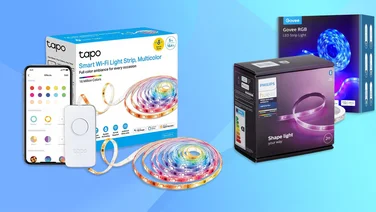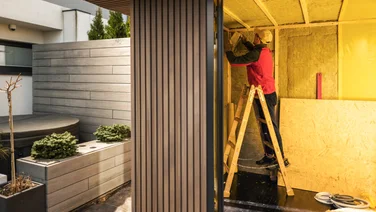To help us provide you with free impartial advice, we may earn a commission if you buy through links on our site. Learn more
- Best smart bulbs: At a glance
- How to choose the best smart bulbs for you
- How we test smart bulbs
- The best smart bulbs you can buy in 2024
- 1. Philips Hue: Best smart lighting system
- 2. Hive Active Lighting: Best smart light bulbs for a growing smart home
- 3. Ikea TRÅDFRI: Best budget smart bulb starter kit
- 4. Innr: Best budget smart bulbs
- 5. Meross MSL120: Best budget Wi-Fi bulbs
- 6. Tapo L535E Matter Smart Wi-Fi LED bulb: Best Wi-Fi bulbs for features
- 7. Govee Smart A19 LED light bulbs: Best Wi-Fi bulbs for entertainment
- 8. Govee M1 LED strip light: Best Wi-Fi LED light strip

Smart light bulbs make a great first step into making your home smarter. Kit yourself out with a few energy-efficient LED bulbs, and you can have lights that work with your daily routine automatically or that you can turn on and turn off with voice commands. Add sensors and switches for a lighting system where bulbs only turn on when someone’s in the room, or that switch on when you come through the door. It’s not only convenient, but could save you money in the long run.
What’s more, with tunable white and coloured bulbs and lighting strips, you can change the way you use light and colour. Why not add a splash of pink or blue to a shady corner, or have lighting you can change to match what you’re doing, whether that’s watching movies, entertaining or chilling out before you go to bed? You can even use bulbs to mimic natural light – a real plus if you suffer from SAD during the winter months.
Finding smart bulbs is easy, with a wide range of manufacturers and products covering different needs and price points. Choosing which to buy is a little more tricky; with different systems, types and connectivity standards to contend with, you want to make sure you pick the right bulbs for you. That’s where we come in. We’ve tested smart bulbs and lighting products from all the major manufacturers and created a shortlist of the best. We’ve also created a detailed buying guide to help you find the best options for your home.
Best smart bulbs: At a glance
| Best smart bulb system | Philips Hue (~£80) | |
| Best budget starter kit: | TRÅDFRI (~£60) | |
| Best budget Wi-Fi bulbs | Meross LS120 (~£17) | |
| Best Wi-Fi bulbs for entertainment | Govee A19 (~£26) |
How to choose the best smart bulbs for you
What is a smart bulb, and how does it work?
A smart bulb is a light bulb that connects to an app and the internet through your Wi-Fi network or a special wireless network controlled by what’s called a “bridge” or “hub.” This enables app support, voice control and a host of other features. Smart bulbs can:
- Change colour, temperature and brightness, as mentioned above
- Function via an app (even if you aren’t at home) or a supported smart speaker
- Run on timers set via the dedicated smartphone app in question
All smart bulbs include some kind of wireless connectivity. Some use a specialist wireless network designed for smart homes, such as Zigbee or the newer Thread. Others use ordinary Wi-Fi, and connect directly to your router. Without a connection, a smart bulb is essentially just a standard LED light bulb.
Although brands may vary, most smart bulbs come in the major socket types (E14, E27, B22, GU10) and three distinct flavours – single colour, tuneable (warm/cold white) and multicoloured – that increase in price from left to right.
Many smart bulbs work within a system, with a hub or bridge that plugs into your router and controls any bulbs and switches on the network. Hive Active Lighting and Hue are the most popular of these systems. Those that use Wi-Fi are usually designed to work with their manufacturer’s specific app, although the app might also set up integration with Alexa or Google Home voice controls.
Any bulbs that use the Zigbee wireless standard, including Hue bulbs, can also be controlled directly by some Amazon Echo speakers using the Alexa app and Alexa voice controls, with the Echo acting as a hub. What’s more, third-party Zigbee bulbs will also work within a Hue system – and some make great, cost-conscious alternatives to the more expensive Hue bulbs. Just be aware that these third-party bulbs might not support all features of the Hue system, while the Alexa app might not support all the features of, say, a Hue bulb.
Wi-Fi bulbs have become more popular in recent years, with competition between brands bringing prices right down. However, you might find some of the cheaper brands offer limited features or are unreliable, while some older routers struggle with managing a bunch of smart bulbs on top of all the smartphones, tablets, laptops, consoles and TVs you might find in the average home.
Incompatibility between brands and systems has always held back the adoption of smart bulbs; but now that manufacturers have agreed on an open standard, Matter, and a network technology, Thread, this may become a thing of the past. Until Matter and Thread-compatible bulbs appear en-masse, it’s difficult to say.
Do smart bulbs use more electricity?
Smart bulbs must be constantly on to function as intended, which raises some questions over energy usage. However, we’re only talking about 0.2 to 0.5W with most bulbs, so even with today’s energy prices, they’re not going to break the bank – nor contribute to destroying the world. What’s more, smart bulbs use energy-efficient LED technology to do the actual lighting, using a fraction of the energy in conventional or halogen bulbs. And, arguably, by making the most of their scheduling and power-saving features, you could make sure that they’re only turned on when they’re needed – and not left on when they’re not. This alone should reduce their environmental impact and help you save a few quid on your annual lighting bill.
How long do smart bulbs last?
This will vary by brand, but all major manufacturers will list a quoted life span for each of their major products. at the top end, the likes of Philips Hue, Hive Active Lighting and Ikea TRÅDFRI claim to last for around 25,000 hours (almost three years) of constant use; even at the bottom end of the spectrum, TP-Link’s Kasa bulbs will apparently run for around 15,000 hours in total. In short, smart light bulbs last an extraordinarily long time.
Do you have to use the app to turn smart bulbs on?
Not necessarily. Most bulbs and systems will work with Alexa, Google Home and Google Assistant voice commands, so with a handful of phrases you can turn off anything from the standard lamp in the lounge to all the lights in your house.
Do smart bulbs work with switches?
Yes! Some manufacturers have their own wireless switches, which you can use to turn on, dim and turn off specific lights, or even a whole bunch of lights at once. And some systems will work with motion sensors so that lights turn on/off when you enter/leave a room.
As a fallback, you can always turn lights on and off using existing physical switches. Do this and they’ll usually come on at their last brightness level, but you’ll find some coming on at full brightness – which isn’t a treat when you turn the bedside light on early in the morning. Also, keep in mind that turning a smart light bulb off via a physical switch will prevent it from working with an app or smart speaker.
How we test smart bulbs
We test smart bulbs by running the setup and configuration process through the app, as instructed by the manufacturer, connecting either directly to a test Wi-Fi network or through the manufacturer’s hub, where supplied. Having got the bulb or bulbs up and running, we use the app to test their features, setting up schedules for them to turn on and off, and grouping them together in routines or scenes. In addition, we test any colour-changing features or fade and intensity settings. We also set them up with Google Home and Alexa smart speakers, to see how effectively any voice controls work. Where switches or sensors are available as part of the system, we also put them to the test.
READ NEXT: Best smart thermostat
The best smart bulbs you can buy in 2024
1. Philips Hue: Best smart lighting system
Price when reviewed: £80 (starter kit) | Check price at Amazon

Philips’ Hue range did a lot to popularise smart lighting, and it’s matured into the most comprehensive system on the market. Setting it up is extremely straightforward; connect the compact bridge unit to your router, screw in the bulbs and you’re pretty much away. The latest version of the starter kit includes two bulbs in either E27 or B22 varieties, plus the hub and a dimmer switch.
For more bulbs, Hue covers everything from basic tunable white and coloured bulbs to GU10 spotlights, lamps, lighting strips, bar lights and even outdoor lighting. What’s more, as it uses Zigbee to connect, it will also work with third-party Zigbee bulbs – you won’t get the full range of features though. Features like syncing with your TV.
The app makes short work of adding bulbs, other lights, sensors, switches and smart plugs. You can also configure them in rooms or even create specific lighting zones that might cover just one corner of a room or a whole floor of your house. You can then schedule when lights go on or off, set up complex routines to handle what happens when a sensor gets triggered or you click a switch and you can also trigger these routines to work with Amazon Alexa or Google Assistant voice commands.
Annoyingly, these only work with the Hue Sync app for Windows or MacOS, so if your source is a streaming stick, Blu-ray player or games console, you’ll need the separate HDMI Play sync box (£230), which analyses the content coming to your TV to sync up to four Hue lights. The biggest issue with Hue is that the bulbs can be expensive, especially compared to cheaper Wi-Fi brands, but if you want a simple-to-use, tightly integrated system, it’s by far the most obvious choice.
Key specs – Type: ZigBee smart lighting system with Ethernet hub; Bulbs available: E27, B22, E14, GU10, smart lamps, LED light strips, outdoor lighting; Tuneable bulbs: Yes; Colour bulbs: Yes; Scheduling: Yes; Sensors: Motion; Switches: Yes
2. Hive Active Lighting: Best smart light bulbs for a growing smart home

Price when reviewed: £99 (Starter kit) | Check price at HiveHive is the smart home brand of Centrica, the company behind British Gas, and it offers smart lighting as part of a portfolio that also includes heating and EV charging products. This is one of Hive’s strengths, as it means your lighting can work in tandem with a full range of sensors, smart plugs and thermostats. You even get a choice of starter kits, with one that includes the hub, two bulbs and a motion sensor, and another that bundles in a smart plug on top.
You can set routines to make lights and heating come on in the morning or evening, or use sensors to turn them on when you come through the door later on. We’re also big fans of Hive’s mimic feature, which turns your lights on and off automatically when you’re away.
Hive can’t match Philips’ range of lamps and strip lights, but the system has evolved to include a good selection of E27 and B22 bulbs, candle bulbs and spotlights, in both dimmable and tunable white or colour versions. The only major niggle is a lack of physical buttons or rotary switches, meaning you have to use the app, voice controls or sensors. Luckily, Hive works with Homekit, Google Home and Amazon Alexa.
The lights themselves are very reliable and the whole setup is easy to get up and running. If you have ambitious plans for a smarter home, Hive is a good place to start.
Key specs – Type: ZigBee smart lighting system with Ethernet or wireless hub; Bulbs available: E27, B22, E14, GU10; Tuneable bulbs: Yes; Colour bulbs: Yes; Scheduling: Yes; Sensors: Motion, door; Switches: No
3. Ikea TRÅDFRI: Best budget smart bulb starter kit

Price when reviewed: £60 (Dirigera hub) | Check price at IkeaLooking for a DIY smart lighting kit at a bargain-basement price? Well, it’s hardly surprising that Ikea has the answer. From the Swedish home of tasty meatballs and stylish flat pack furniture, the TRÅDFRI system gives you plenty of choice. At the most basic level, you can pair a wireless bulb with a wireless dimmer switch and have dimmable lighting in one room without touching an app. However, if you want more control, you’ll need to connect the £60 Dirigera smart product hub to your router. From there, you can fit the Zigbee-compatible TRÅDFRI bulbs around the house and have a full-on smart lighting system for less than you would pay elsewhere.
The TRÅDFRI range used to be fairly basic, but Ikea has expanded it to include a wider range of bulbs, smart plugs, worktop lights, led lighting strips, sensors and buttons, while the app has grown slicker with a stronger set of features. It’s also become easier to control your setup through Alexa, Homekit and Google Home voice controls, making it a more viable – if less exciting – alternative to Philips Hue. And while Hue still has the edge when it comes to flashy features, Ikea predictably does better when it comes to price and value.
Key specs – Type: Various; Bulbs available: E27, E14, GU10; Tuneable bulbs: Yes; Colour bulbs: Yes; Scheduling: Yes; Sensors: No; Switches: Yes
4. Innr: Best budget smart bulbs

Price when reviewed: £23 (2x bulbs) | Check price at AmazonInnr doesn’t manufacture smart lighting systems, but it does manufacture bulbs you can use with a Hue bridge or directly with an Echo Plus. We’ve found the bulbs to be a little trickier to set up than the Hue equivalents but once up and running they’re very reliable.
The white and tuneable bulbs deliver a good light, while the colour bulbs are only a little behind the Hue bulbs in terms of quality. The Hub colours are more vibrant, but the difference isn’t huge.
There are a few limitations, as Innr’s bulbs don’t support some of Hue’s advanced features. However, the Innr range has grown to cover a wider range of bulbs, including coloured GU10s and cool, retro filament-style efforts; its coloured bulbs are significantly cheaper than the competition. In fact, if you’re putting together a cheap lighting setup with an Amazon Echo as a hub, or simply filling in the gaps in a Hue setup, then using Innr is a great way to save money. You can often save £10 off the normal price or bag two bulbs for the price of one.
Key specs – Type: ZigBee smart lighting bulbs; Bulbs available: E27, B22, E14, GU10; Tuneable bulbs: Yes; Colour bulbs: Yes; Scheduling: N/A; Sensors: N/A; Switches: N/A
5. Meross MSL120: Best budget Wi-Fi bulbs

Price when reviewed: £14 (1x bulb), £17 (2x bulbs) | Check price at Amazon
Meross’s bulbs aren’t particularly cheap bought one at a time, but you can regularly find them at under £20 for a pack of two. What’s more, these aren’t basic white or tuneable white bulbs, but 16.7 million colour RGB efforts. If you want to paint your home with warm or splashy neon colours, you won’t find many cheaper ways to do it.
Crucially, there’s no compromise on quality. The bulbs feel well-made and have an estimated lifespan of around 22 years. Connectivity can be hit and miss on the fringes of your router’s Wi-Fi range, but the same is true of much more expensive bulbs and if you have a mesh network or extender, then you shouldn’t have any problems.
The bulbs work with the same app used to control Meross’ Wi-Fi mains extensions and smart sockets, and it provides full control of brightness, tone and colour. You can assign bulbs to scenes and set up routines, setting colours for specific moods or activities.
Meanwhile, Alexa voice controls allow you to change the brightness or colour with simple commands, with Google Home and Samsung SmartThings also supported. Setting up a smarter home with limited cash? These are the bulbs to buy.
Key specs – Type: Wi-Fi smart lighting bulbs; Bulbs available: E27, B22; Tuneable bulbs: Yes; Colour bulbs: Yes; Scheduling: Yes; Sensors: No; Switches: Yes
6. Tapo L535E Matter Smart Wi-Fi LED bulb: Best Wi-Fi bulbs for features

Price when reviewed: £15 (1x bulbs) | Check price at Amazon
Combined with Tapo’s smartphone app, the L535E Matter Smart Wi-Fi LED bulb packs in an impressive range of capabilities. Users with a Google Matter hub can configure it with a QR code using Google’s Matter tech, or you can use the Tap app to connect the bulb directly via Wi-Fi. From there on in, you can use the app to select the white colour temperature and brightness level, or switch to a full RGB palette of 16.7 million hues.
What’s more, you can create your own colour presets, or use auto mode to adjust the colour temperature to match the natural light for that time of day or vary the brightness to maintain a consistent level of light throughout the day.
That’s not all. Themes give you customisable settings that cycle through colours, while you can use timers and schedules to turn lights on or off, with an Away setting to turn lights on and off while you’re out of the house. The app even tracks how much each bulb gets used and how much energy it’s consuming. It’s disappointing that there’s currently no B22 version – though a Tapo bulb with most of the features is available, just with no Matter support. This feels like the light bulb of the future, and it’s still fairly inexpensive.
Key specs – Type: Wi-Fi smart lighting bulbs; Bulbs available: E27; Tuneable bulbs: Yes; Colour bulbs: Yes; Scheduling: Yes; Sensors: No; Switches: No
7. Govee Smart A19 LED light bulbs: Best Wi-Fi bulbs for entertainment

Price when reviewed: £17 (1x bulb) | Check price at Amazon
Govee’s bulbs can often be found at bargain prices, yet with their chunky plastic shroud and solid build quality, they look and feel anything but cheap. What’s more, with a choice of 2,700K to 6,500K white tones and 16.7 million colours you’ve got a massive palette of hues and tones to work with, though we found the ability to set the brightness level by single 1% increments made little difference below 30%.
This is the Wi-Fi light bulb to come to if you’re looking for entertainment and sheer party power. You can schedule lights to come on or off as normal, or organise bulbs into themed scenes, but Govee goes further with weird and sometimes wonderful pulsing or colour-shifting light patterns, plus features to match the lighting to the input from your smartphone’s mic. It’s the perfect option for parties provided you’re happy to leave a smartphone or tablet out.
You can even mix your own lighting themes through the app’s Effects Lab. With some very tempting 4-bulb bundles to be found, Govee puts the fun into smart lighting, as well as the functional stuff.
Key specs – Type: Wi-Fi smart lighting bulbs; Bulbs available: B22; Tuneable bulbs: Yes; Colour bulbs: Yes; Scheduling: Yes; Sensors: No; Switches: No
8. Govee M1 LED strip light: Best Wi-Fi LED light strip

Price when reviewed: £80 (2m) | Check price at Amazon
Where most Wi-Fi smart bulb manufacturers have stuck to the basic types, Govee has extended into a wider range of outdoor lighting, lighting strips and floor and table lamps. The M1 LED strip light is a popular favourite, giving you a strip of 60 low-output LED lights per metre, in two and five metre lengths.
Each strip has 20 segments that can be tuned with individual tones or colours, and it’s all controlled by the same Govee Home app used to control the brand’s conventional light bulbs.
What’s more, Google’s Matter tech is supported for easy configuration and control, should you have a Matter Hub, though with no QR code in our test kit we had to get the necessary code from Govee’s app after an initial Wi-FI setup.
If you’re looking for subtle glows above or beneath a surface or around a piece of furniture, the M1 LED strip light has you covered, but it can also be set to use a wide range of pulsing, animated colour effects if you’re looking for a party. Some of these go fairly crazy, to put it mildly, even prompting warning notes for seizures in the Govee app, but others take things easy and could work well for relaxation or entertainment.
The control box even integrates a mic for audio sync. You can also schedule the strip to turn on and off at specific times, and there’s still full control through Alexa, Apple Homekit or Google Home. If you want to take your lighting further, this is a great place to start.
Key specs – Type: Wi-Fi LED light strip; Bulbs available: N/A; Tuneable bulbs: Yes; Colour bulbs: Yes; Scheduling: Yes; Sensors: No; Switches: No













